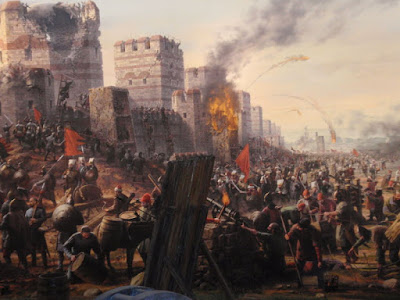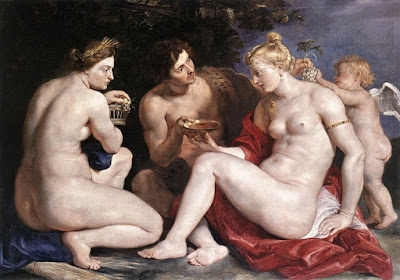 |
| Mehmet II using canons in the Siege of Constantinople, 1452 |
When, in 1453, Sultan Mehmed II brought canons to Constantinople, he did not intend to bring the Middle Ages to a close. This was not even the very first use of newfangled firearms in the West. These had been brought from China, which had been using them for years. But at Constantinople, they proved decisive. In just seven weeks they battered the previously impregnable vertical walls that had propped up the Roman Empire for almost 1500 years. Ever since, it has been hard for historians not to credit this event with a sea change in Western Civilization.
The term ‘renaissance’ literally means rebirth. Just as the old Roman Empire was dying, Italy was discovering interest in its classical roots. The dis-unified, contentious, innovative Italian city states were nothing like their powerful Roman predecessors, but they were built on those ruins, the evidence of antiquity was all around them, and their new found curiosity about that classical world was part of a re-framing of everything from the medieval world.
The story of Joan of Arc’s heretical transvestism from the earlier post is actually a great transitional Renaissance story. In it, Joan’s state of mind is of central interest. This is the primary difference between the Middle Ages and the Renaissance. In the Middle Ages, the states of mind of kings, bishops and popes matter, but commoners do not. St. Joan is unique in being a commoner whose state of mind was worthy of official notice. Even then, it was only noteworthy because warring elites were citing her behavior as proof of divine intervention. In the Renaissance, inquiry and interest in everyone begins to matter. This change was not brought about by the Fall of Constantinople, nor by the use of canons, although that technological change is important. Canons are not a class of weapon wielded by aristocratic warriors, but by commoner technicians whose technical skills in chemistry, metallurgy and physics have become decisive on the battlefield. In the military, as in religion, and in sexuality, what commoner specialists know makes all the difference. And that led to renewed interest in the classical philosophers, and a tectonic shift in which institutions centralized the authority to decide what reality was.
 |
| A modern replica of Johannes Gutenberg’s printing press |
The other crucial event that is often said to demarcate the boundary between the Middle Ages and the Renaissance is the invention of the printing press. This example is a case study in social construction. For the printing press was not invented in the Middle Ages, it had been around since antiquity in the form of the wine press, where it spared everyone the labor-intensive practice of stamping grapes into juice with bare feet. Sometime in the 7th century, the Chinese made the first woodblock printed books. In the 11thcentury, the Koreans had invented wooden movable type. But Chinese bureaucratic class structure was not transformed by this innovation, and Johannes Gutenberg’s 15thcentury use of metallic movable type and the printing of the Gutenberg Bible was transformative. The technical and trading classes of Europe who had been making incremental technical innovations in the thousand years since the fall of the Western Roman Empire had developed the literary skills to read, and a technology that could put books in their hands en mass changed everything.
 |
| Cochem, Germany, as viewed from Reichsberg Castle |
Which brings us to the town of Cochem on the Moselle River, some 75 miles from bustling Mainz where Johannes press first started the mass production of the Bible. This sleepy little wine town is nestled on the narrow flood plain of the Moselle between the steep vine-covered slopes that have been devoted to its primary craft for the last 2000 years. Before us is a fountain of a goat being crushed in a wine press. Lest you think its resident’s unduly harsh and bloodthirsty, the story of this fountain is actually proof of the importance of wine and of their piety.
 |
| Cochem’s Goat Fountain (photo by the author.) |
For the town has always observed that, in the last week of the growing season, when the grapes are most sweet and tempting, the vines are off limits to residents and animals alike. It is death to be found stealing from the vines during the crucial final period of greatest ripeness. Yet a boy and a goat have been found in the fields. The boy has gone in to retrieve his pet. He is a good and god-fearing son of a vinter whose disclaimer is to be believed by all. But how is the animal’s innocence to be determined? The vinter finally suggests the goat be placed on the press. If the goat is guilty of eating grapes, his blood will flow purple with the color of the juice. If he is innocent, his red blood will flow clear of corruption. Eventually the goat dies, his blood flowing clear, verifying the boy’s story and proving the goat was a good animal and had not partaken of the grapes, and the citizens are satisfied of the sanctity of their crops, the boy and the goat. All is well in Cochem!
 |
| Reichsberg Castle as seen from Cochem (photo by genuine professionals!) |
Overlooking the town is Reichsberg Castle. Originally built in the 11thcentury, Louis the XIV knocked most of it down in 1689 during his devastation of the Palatinate during the War of the League of Augsburg. In the mid-19th century, Reichsberg Castle was rebuilt in the neo-romantic style, with only the Hexenturm, or ‘Witches Tower’ preserved from the original 11thcentury ruins. This tower got its name from the practice of trying witches by throwing them from the 40-foot-high window. Since no mortal could survive the fall, a suspect was obviously acquitted if she died from the fall. Those few who survived were immediately put to death for witchcraft.
 |
| The Hexenturm is on the left, a Neo-Romantic turret occupies the center. Witches were thrown from the arch. (photo by the author.) |
The similarity of these two Cochem stories, with their devotion to a less-than-modern conception of empiricism, reads as Pythonesque today. But like the Spanish Inquisition, which sentenced prisoners to death as the inevitable choice between two goods; the inquisitors contrived to preserve the protagonists soul, not their lives. An innocent was consigned directly to Heaven, and their purity preserved. The guilty were dispatched to hell and the purity of the community preserved. Intention and adherence to law mattered more than life itself.
 |
| “And how do we know she’s a witch?” (still from Monty Python and the Holy Grail — 1975) |
It is not surprising at this time that people became less tolerant of sexual variations that previously did not provoke much notice. Sex stopped becoming a merely animal matter, or a simple function of power, and started to attain symbolic significance not unlike the Augustinian battle against paganism. Before the Renaissance, behavior proved belief. Pagans were converted or put to death because of their behavior. Now that belief mattered, the boundaries changed, and you could be persecuted for thinking the wrong thing.
Not that the church found sex behavior beneath its notice after paganism had largely been replaced by Christian belief. Thomas Aquinas declared it unnatural in his disquisition on natural law, and church doctrine had been vaguely opposed to sensuality since St Augustine. But, like St Joan’s heresy of wearing armor, church doctrine around variant sexual expression was there as a basis for prosecution if a dissident defied Church teaching.
 |
| The first recorded execution for sodomy was in the 13th century in Ghent. This etching, a contemporary of the printing press, probably depicts persecution of anabaptists. Anabaptists, including Mennonites, Amish, Hitterites and other Protestant sects, believed in deferring baptism until the age of consent. This was objectionable to Catholics and other Protestants who believed children went directly to Hell if they died having not first been baptized. |
It is quite difficult from the vantage point of the early twenty-first century to recognize the extent of the cataclysm this would provoke. The 30 Years War, the French Wars of Religion, The English Civil War, and, and Spanish attempts to subdue the low countries were catastrophes that depopulated the Rhine, bankrupted major powers, and drove emigration to the New World. An increasingly urbanized population had more opportunities for sexual deviance, but the rising power of states and decreased privacy meant more opportunities for sexual pogroms and repression. And both the church and the state cared about what one thought, not just how they behaved.
 |
| A contemporary production of Romeo and Juliet “It was the nightingale and not the lark, that pierc’d the fearful hollow of thine ear!” |
The new liberalism and repression are evident in the work of William Shakespeare. Full of bawdy references, Shakespeare is ribald enough today that social conservatives are often made uncomfortable teaching it in high school. But Shakespeare and all London theater went through periods in which the theaters were regarded as hotbeds of immorality and were periodically shut down entirely on religious grounds. All the female parts were played by teenage males because the theater was associated with vice and prostitution. It was commonly thought that many actors were gay. After the reign of Elizabeth I the theaters were closed altogether following the English Civil War. At the conclusion of Cromwell’s puritanical reign, the theaters would reopen with a ribald vengeance during the Restoration. This same conflict about representation of the erotic could be seen in Dutch and Flemish painting as the interest in peasant and interior life gave rise to eroticism, and this was alternately exposed, repressed, and restored. Sex lives mattered during the restoration and Counter-Reformation, but mainly in the context of a contested set of social constructions aimed at demonstrating the superiority of one form of religion over another.
 |
| Venus, Cupid, Bacchus, and Ceres (1612-13) by Peter Paul Rubens in the Counter-Reformation’s return to eroticism. |
Foucault would later criticize the idea that the Western relationship to sexuality was primarily one of Freudian repression. But in the Renaissance, as society became increasing professionalized by a tiny but rising middle class, there was an initial struggle over repression. This was not primarily about sex itself. In the rural Middle Ages and Renaissance, it was hard to come down too hard on reproduction when children were and economic asset and the countryside depopulated by war and disease. But sex became one more battle ground in the war over belief and the forced decentralization of church authority to dictate what reality was.
© Russell J Stambaugh, October 2015, Ann Arbor, MI. All Rights Reserved.









